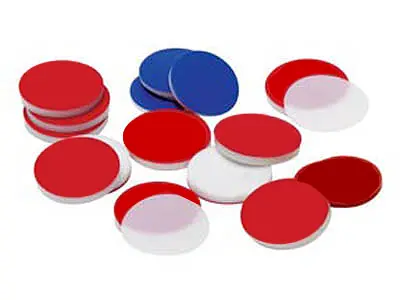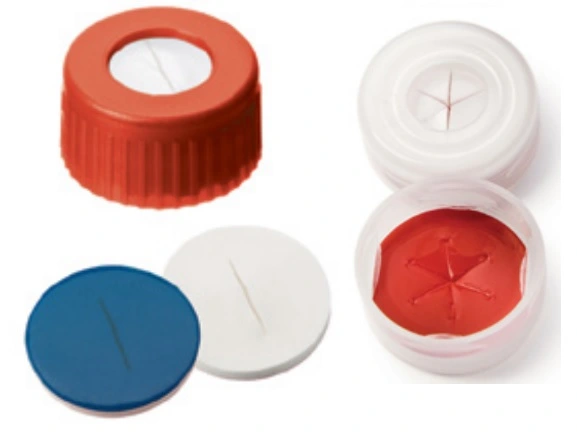- 3% Discount on online orders
- Fast Delivery Times
- DIN ISO 9001:2015 Certified
- Manufacturer Expertise
- Contact Us
Checkout using your account
Checkout as a new customer
Creating an account has many benefits:
- See order and shipping status
- Track order history
- Check out faster
Vial Septa
Vial septa serve as sealing elements between the vial and the cap and ensure that the sample is securely sealed and protected from contamination. They allow for sampling while the vial remains shut and can withstand repeated needle punctures without losing their seal, which can be particularly important in automated systems.
Septa are available in different materials, each offering specific properties and advantages. The most common materials are polytetrafluoroethylene (PTFE), silicone, and a combination of both (PTFE/silicone).

Products
Technical Data
Choosing the right material
The material from which a septum is made is decisive for its suitability for your application. The material determines the hardness and chemical resistance of a septum. The hardness and thickness must be compatible with the needle tip of your autosampler so that the septum can be pierced without any problems. A septum must also be chemically resistant to your sample, otherwise leaks or contamination from dissolved septum material may occur. The compatibility of typical materials with common solvents can be found in the table below.
A septum can also be made of multiplel materials. A common design is silicone with PTFE lining, which utilises the good mechanical properties of the silicone on the upper side and has a thin layer of chemically highly resistant PTFE on the vessel side. The Combination of Butyl/PTFA is also frequently found. Here the bad chemical resistance of Butyl rubber is compansated by the PTFE-lining and the good tightness of Butyl rubber becomes more widely applicable.
Overview: Which septa materials are compatible with which solvents?
PTFE | Rubber | Silicone | Butyl rubber | |
| Acids | very good | good | very good | sufficient |
| diluted Acids | very good | good | good | sufficient |
| Acetone | very good | good | poor | good |
| Alcohols | very good | sufficient | good | good |
| Benzene | very good | poor | sufficient | poor |
| Chloroform | very good | poor | good | sufficient |
| Dioxane | very good | sufficient | good | poor |
| Ethyl acetate | very good | good | very good | sufficient |
| Ethanol | very good | very good | good | sufficient |
| Halogenated hydrocarbons | very good | poor | very good | poor |
| Hexane | very good | bad | good | bad |
| Ketones | very good | very good | sufficient | good |
| Methanol | very good | good | very good | good |
| Pentane | very good | poor | good | bad |
| Sulphuric acid | very good | sufficient | good | poor |
| Surfactants | very good | very good | very good | adequate |
| Toluene | very good | sufficient | good | poor |
| Water | very good | very good | very good | good |
PFAS analysis
When analysing PFAS, PTFE must be completely avoided when selecting a septum in order to guarantee the accuracy of your results. Typically, pure silicone septa are used here.
For information on special product lines for PFAS analysis, please also visit our page on PFAS.

Pre-slit septa
In addition to the classic version, septa are also available in a pre-slit version. Pre-slit septa are easier to pierce, which gives them a wider compatibility and makes them less prone to errors. In addition, the phenomenon of coring, i.e. parts of the septum breaking off during piercing, is largely suppressed. Coring can lead to a contamination of the sample and may cause ghost peaks to appear in the chromatogram.
The right column for you - we will be happy to support you individually
Competent consultants are always at your side. Write a message to our consultants, we will get back to you and give you individual support.
